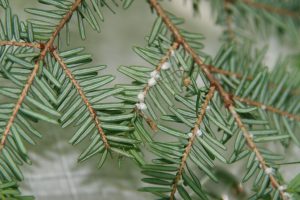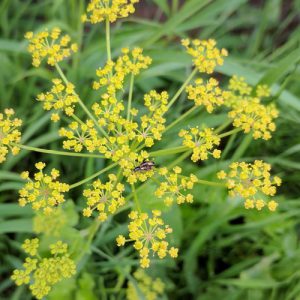
The changing of the seasons in Canada brings back some of our most beloved species. Migratory birds fly back north, our gardens come alive and buds reappear on the trees. As spring turns to summer, the warming weather can also bring some less-than-desirable species, including invasive species.
While invasive species management varies across a landscape as large as Canada, one thing remains constant: the earlier you detect an invasive species, the better! Summer is an excellent time to survey your yards and local parks for potential invasive species. There’s no time like now to grab a cell phone or clipboard and a camera and get started!
One pesky insect to be on the lookout for in Eastern and Central Canada is the invasive hemlock woolly adelgid. This aphid-like insect sucks the fluid from plants and is a menace to eastern hemlock trees. Hemlocks are an important species for birds and mammals. The hemlock tree, commonly found in ravines and cool mixed woods, plays an important role in regulating stream temperatures. To date, this bug is found only in Nova Scotia and Southern Ontario.

This tiny pest can hitch a ride on infested wood and nursery stock as well as birds and mammals. It makes its egg sacs, which look like tiny balls of wool, on the underside of hemlock branches in the spring to early summer. Look for these egg sacs and consider trying ball sampling (a fun family activity!) or sticky trap sampling to monitor the health of your hemlocks, especially if you live close to current populations. Finally, avoid placing your bird feeders too close to a hemlock tree in infected areas, as the insects can hitch a ride on the feathers of birds into new areas!
In the heat of the summer, there are two members of the carrot family to watch out for as well. Both giant hogweed and wild parsnip are well known for the sap in their stems that can react with sunlight when on the skin to cause burns or rashes. Giant hogweed can be 2-5.5 m tall and from late spring to mid-summer it produces a large upside-down umbrella-shaped head with clusters of tiny white flowers. Wild parsnip can be identified by its yellow flower clusters and also grows to be quite tall at up to 1.5m.


If you see either of these plants leave them be and assess the situation. Best management practices guides can give you insight into whether the plants are sparse and young enough to remove yourself or large and widespread enough to get professional help. Either way, ensure that proper safety precautions like eye and skin protection are met, to reduce the chances of contact with the toxic sap for workers and others. Giant hogweed and wild parsnip share similarities in appearance with cow parsnip and Queen Anne’s lace which you may also find in your area.
Accidentally buying invasive species is another way they can show up in our backyards and woodlots. Popular pond plants have a high potential to become invasive if they escape your backyard. For example, water hyacinth, water lettuce, parrot feather and yellow floating heart can all put our Canadian biodiversity at risk. Accidental escape can happen by flooding into a nearby waterbody or through bird movement. Avoid contributing to the sale of invasive plants and always select native aquatic plants for your pond.
So, what should you do if you find an invasive species? Report it!
In Canada, there are a lot of ways to report invasive species. Documenting your sighting helps the invasive species community to understand species distribution and spread over time. Reporting is especially important if it is a high-priority species not known to be present in your area, like hemlock woolly adelgid.
In the meantime, follow these tips to make sure your backyard stays invasive species-free:
- Only use firewood sourced from local forests, and don’t transport it over distances of 80 kilometres. A good rule of thumb is 20 km or less!
- When purchasing your garden and pond plants, always choose plants native to your area.
- Avoid moving soil out of your area, as it could be filled with invasive plant parts, pests or pathogens.
For more information on invasive species, browse the Invasive Species Centre website.
